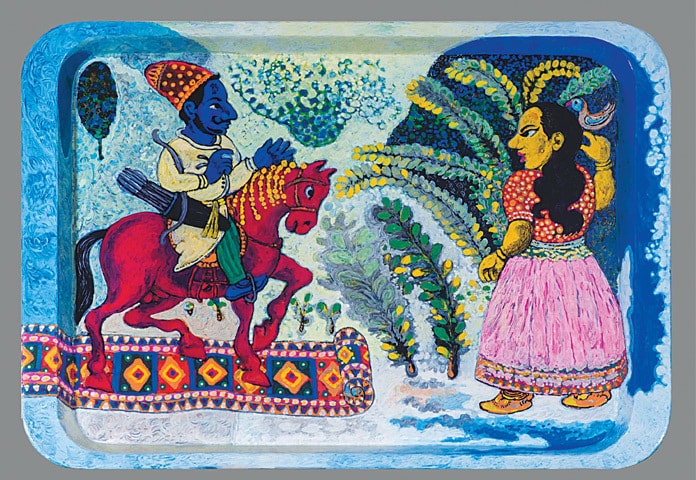
In the film Her, the main character Theodore is shown suffering from loneliness. We begin to realise this by noticing little details: he is seen dressed in unusually bright colours such as red or yellow, yet he himself appears lifeless or, conversely, he is placed against bright backdrops in drab clothing. In both instances, we sense the same thing: that he is experiencing everyday life differently from everyone and we are unsettled — it is as if he is walking through a dream that reflects his emotions. Using colour and conveying this splicing of time, where dream and reality merge, has often been the mainstay of many painters and requires a certain kind of poetic sensibility. Eminent painter and printmaker Afshar Malik has used these devices quite regularly in his mixed media works, where he likes to merge the sacred and the profane, dream and reality, as if these dualities are intrinsic to our existence.
His recent body of work, titled Oneness in a Blue Moon, is striking and almost iconoclastic in approach. While he is known for his mixed media works, he flouts convention completely for kitsch this time: not only does he ramp up the colour quotient by using industrial metallic markers but he “serves” us these magical, multi-hued, riotous tales of love and longing in synthetic hues on melamine trays — literally.
All of Malik’s works are executed on cheap plastic trays, which are often used as colour pallettes for paintings; he describes this “as a mixing of palette and paint into a state of oneness.”
This fusion or the ‘state of oneness’ is also reflected in his content, presentation and his use of nautanki as a mode of expression on a two-dimensional surface. Historically, many Rajasthani court paintings and paintings from the Punjab hills were known to illustrate an entire sequence of the same scene in one painting; by dividing the page into frames or sections, the characters seemed to perform a nautanki or vignettes, as if on stage. Each of Malik’s tray paintings, too, drawn from a fusion of folktales, Fauvism and texts about love, such as the Rasamanjari and Ragamalas, resembles a single vignette — albeit one that fuses folktale and fantasy with a dollop of urban kitsch.

Afshar Malik merges the sacred and the profane in his new body of work
For instance, ‘The Two Only’ reminds one of a Kangra painting where Krishna is seen wooing and eventually canoodling Radha in various stages in the same picture plane. In Malik’s painting, we are witness to only one vignette of amorous passion; a male figure dressed in courtly clothes of azure blue is entwined with a female, dressed in fiery red, but there is a twist. Partially visible amidst the dense foliage behind the couple is a large cut-out of an inordinately large wrist watch, probably culled from a magazine. Such pithy humour about temporality also extends to curtly phrased titles such as ‘We Sleep that Ends it’ which shows a multitude of unblinking eyes staring back at us or ‘Little More Umbrella’, where a muscular wrestler is suspended in air as if in a state of contemplative meditation while a buxom woman clad in jeans and a T-shirt floats up, as if in a Marc Chagall painting, to meet him with the help of the most miniscule of umbrellas.
Above all, these paintings resembling cinematic stills tell stories of tender love that seems to transcend context. The vulnerability of this love is captured in scenes of frolicking, longing, parting, waiting or meeting, as if we are in a state of half-wakeful dreaming. The woman could be Sita, Radha, odalisque, a gopi or a washer woman. The man could be Krishna, a mythical hero, a ghostly lovelorn horseman, or just an ordinary man who can’t sleep. These archetypes of men and women that are interspersed with animals and ebullient colours are timeless characters but, as they are “served” up to us — literally and metaphorically — by Malik in new avatars, can they escape scrutiny and desensitised consumption in this era of capitalism?
Malik’s choice of medium also compels us to debate on whether love and human emotions should be expressed in a new way in a new age.
“Oneness in a Blue Moon” was displayed at O Art Space in Lahore from February 28 to March 9, 2020
Published in Dawn, EOS, March 29th, 2020














































Dear visitor, the comments section is undergoing an overhaul and will return soon.